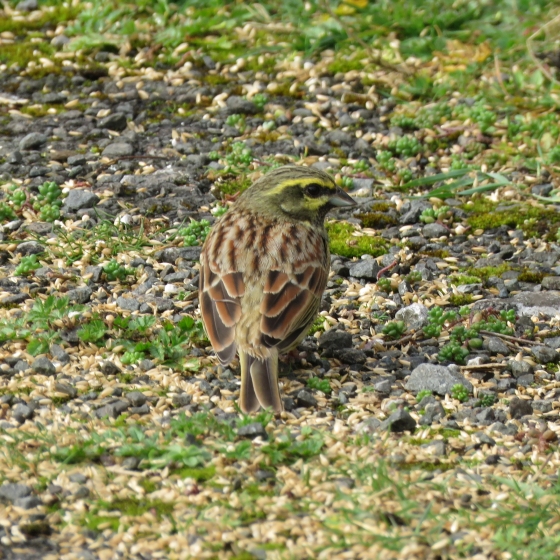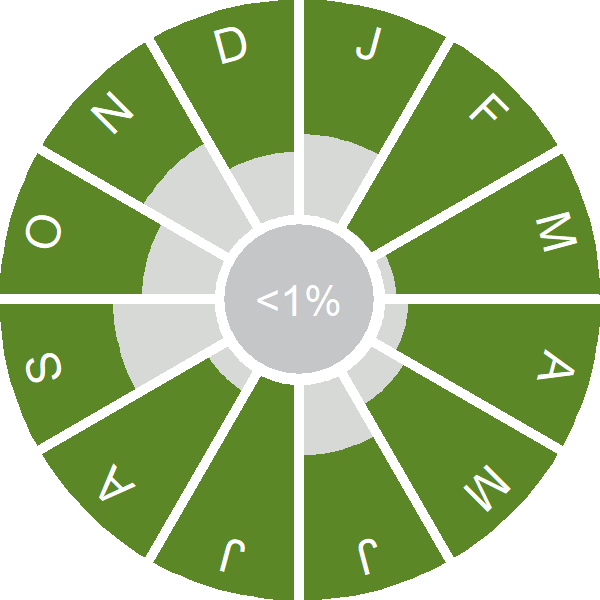Cirl Bunting

Introduction
This attractive species has a breeding and wintering range restricted to South-west England, namely southern Devon and Cornwall.
Its small range and population size means the Cirl Bunting has been on the UK Red List since 1996. Habitat improvements linked to targeted agri-environment scheme have seen numbers increase, and a re-introduction project has brought birds to Cornwall, extending the species range west from Devon.
The Cirl Bunting is a striking bird. Males have distinctive black and yellow facial stripes and chestnut brown on the wings. Females and juveniles are duller and look more similar to Yellowhammers.

Key Stats
Identification
ID Videos
This section features BTO training videos headlining this species, or featuring it as a potential confusion species.
Farmland buntings
Songs and Calls
Song:
Call:
Status and Trends
Conservation Status
Population Change
Until the 1930s, the Cirl Bunting was a widespread breeding bird in Britain and found as far north as North Wales and Yorkshire (Evans 1992) It was still widespread but very localised across southern England at the time of the 1968–72 Breeding Atlas (Sharrock 1976), but further declines occurred during the 1970s (Sitters 1982) and by 1989 the species had become almost entirely restricted to a small area in Devon with a population of only around 118 territories (Evans 1992). Intensive conservation efforts have led to a partial recovery and, although still restricted to south-west England, the population has grown considerably. The last full survey in 2016 estimated a population of 1,079 breeding pairs (Jeffs et al. 2018).
Distribution
Cirl Buntings were formerly widespread breeders across southern England and Wales, and a resident of the Channel Islands. Nowadays they are confined to a narrow coastal strip of south Devon and to east Cornwall where birds have been reintroduced.
Occupied 10-km squares in UK
or view it on Bird Atlas Mapstore.
or view it on Bird Atlas Mapstore.
European Distribution Map
Distribution Change
Until around 1930
Change in occupied 10-km squares in the UK
or view it on Bird Atlas Mapstore.
or view it on Bird Atlas Mapstore.
Seasonality
Cirl Bunting is a localised resident and recorded throughout the year.
Weekly pattern of occurrence
The graph shows when the species is present in the UK, with taller bars indicating a higher likelihood of encountering the species in appropriate regions and habitats.

Movement
Britain & Ireland movement
Foreign locations of birds ringed or recovered in Britain & Ireland
Dots show the foreign destinations of birds ringed in Britain & Ireland, and the origins of birds ringed overseas that were subsequently recaptured, resighted or found dead in Britain & Ireland. Dot colours indicate the time of year that the species was present at the location.
- Winter (Nov-Feb)
- Spring (Mar-Apr)
- Summer (May-Jul)
- Autumn (Aug-Oct)

Biology
Productivity and Nesting
Nesting timing
Egg measurements
Clutch Size
Incubation
Survival and Longevity
Survival is shown as the proportion of birds surviving from one year to the next and is derived from bird ringing data. It can also be used to estimate how long birds typically live.
View number ringed each year in the Online Ringing Report.
Biometrics
Wing length and body weights are from live birds (source).
Ring Size
Classification, names and codes
Classification and Codes
- Order: Passeriformes
- Family: Emberizidae
- Scientific name: Emberiza cirlus
- Authority: Linnaeus, 1766
- BTO 2-letter code: CL
- BTO 5-letter code: CIRBU
- Euring code number: 18580
Alternate species names
- Catalan: gratapalles
- Czech: strnad cvrcivý
- Danish: Gærdeværling
- Dutch: Cirlgors
- Estonian: viinamäe-tsiitsitaja
- Finnish: pensassirkku
- French: Bruant zizi
- German: Zaunammer
- Hungarian: sövénysármány
- Icelandic: Álmtittlingur
- Italian: Zigolo nero
- Latvian: žogu sterste
- Lithuanian: daržine starta
- Norwegian: Hekkspurv
- Polish: cierlik
- Portuguese: escrevedeira
- Slovak: strnádka svrcivá
- Slovenian: plotni strnad
- Spanish: Escribano soteño
- Swedish: häcksparv
- Welsh: Bras Ffrainc
Research
Causes of Change and Solutions
Causes of change
It has been suggested that loss of winter stubbles during the 1970s may have been a major cause of decline (Evans & Smith 1994). Lack of food in the breeding season as a result of agricultural intenstification, and a loss of nesting sites due to hedgerow management may also have contributed (Jeffs et al. 2016). Intensive research and conservation action has resulted in the provision (through agri-environment schemes) of breeding and wintering habitat designed specifically for the species which has driven the recent increases in Cirl Bunting numbers and also benefited other species (MacDonald et al. 2012, Jeffs et al. 2016). However, despite the population increases, there were no initial signs that Cirl Buntings might naturally recolonise sites outside the managed areas (Peach et al. 2001, Stanbury et al. 2010) and the limited availability of fallow and set-aside elsewhere may have prevented more substantial range expansion. The species was reintroduced to Cornwall between 2006 and 2011 (Jeffs et al. 2016) and the most recent survey also shows more encouraging signs of range expansion to north and east Devon although the species remains vulnerable without agri-environment schemes (Jeffs et al. 2018).

